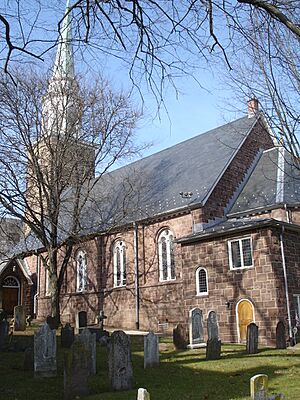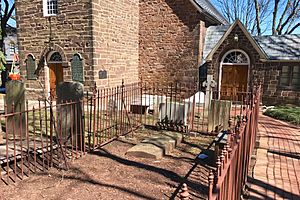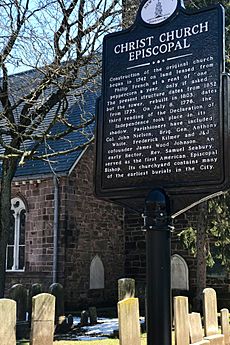Christ Church, New Brunswick, New Jersey facts for kids
Quick facts for kids Christ Church |
|
|---|---|
| The Rector, Church Wardens, and Vestrymen of Christ Church in the City of New Brunswick | |
| Christ Episcopal Church | |
 |
|
| Lua error in Module:Location_map at line 420: attempt to index field 'wikibase' (a nil value). | |
| Location | New Brunswick, New Jersey |
| Country | United States |
| Denomination | Episcopal |
| Weekly attendance | 145 (2014) |
| History | |
| Status | Church |
| Founded | 1761 |
| Events | Third public reading of the Declaration of Independence (which occurred in New Brunswick, July 8, 1776 |
| Architecture | |
| Functional status | Active |
| Architect(s) | Philip French (1750 original) Henry Dudley & Frederick Wills (1852 rebuild) |
| Architectural type | Mission parish |
| Style |
|
| Years built | 1742–49 |
| Groundbreaking | 1742 |
| Completed | 1750 |
| Specifications | |
| Number of spires | 1 |
| Materials | Sandstone rubble while the stone tower is composed of irregularly sized shaley sandstone rubble with a copper roof |
| Administration | |
| Episcopal area | Episcopal Church in the United States of America |
| Diocese | Episcopal Diocese of New Jersey |
| Province | Province II |
Christ Church or Christ Episcopal Church is a very old Episcopal church located in New Brunswick, New Jersey. It has a rich history that goes back to the early 1700s.
Contents
A Look Back: Christ Church History
In 1701, an English minister named Thomas Bray started a group called the Society for the Propagation of the Gospel in Foreign Parts (SPG). Their goal was to help new English settlers. By 1711, a group of Anglicans were holding church services in an old building in Piscataway.
- In 1717, a new wooden church was built for them.
- This church, St. James Parish, grew and included people from New Brunswick.
- Because so many people wanted to attend, a new church, Christ Church, began construction in New Brunswick in 1742.
Getting the Land for the Church
Even though building started in 1742, the church didn't officially own the land until 1745. This was because Philip French, a big landowner in New Brunswick, didn't like to sell land. Instead, he offered land leases for public buildings at a very low cost.
- For Christ Church, he charged a yearly rent of "one peppercorn a year, only if asked."
- This special lease is still on display at Christ Church today!
- For many years, Christ Church was a "mission parish," meaning it was supported by a larger church.
- It became an independent church with its own official permission (a royal charter) in 1761.
Christ Church During the American Revolution
During the American Revolution, Christ Church faced a big challenge. While some members, like Colonel John Neilson and Brigadier General Anthony White, fought for the Patriots (those who wanted independence), others were Loyalists (those who supported the British King).
- One Loyalist was John Antill, who fought with a British-supporting group called the New Jersey Volunteers.
- The church's leader, Reverend Abraham Beach, was in a tough spot. He agreed with the Patriots' goals but couldn't support fighting against the King.
- As an Anglican priest, he had promised to support the King. Church services also included prayers for the King.
- One day, he was threatened if he said these prayers. So, he decided to close the church for the war.
- However, he continued to lead services secretly in people's homes. He sometimes skipped the prayers for the King to avoid upsetting people.
After the War: A New Church Begins
After the war, the newly independent American states worked to form a stronger country. The churches that used to be part of the Church of England also wanted to unite. Reverend Abraham Beach was a key leader in this effort.
- In 1783-1784, he wrote to other church leaders to suggest a meeting.
- He invited them to meet at Christ Church on May 11, 1784.
- This meeting led to a bigger gathering in October 1784 with representatives from all thirteen states.
- They planned the first "General Convention" in September 1785.
- This meeting helped create the Episcopal Church as we know it today, with leaders, clergy, and regular members all having a say.
Music at Christ Church
Music has always been important at Christ Church.
- The church bought its first pipe organ in 1788 for $100.
- In the early 1800s, a choir started under Ann Croes, the daughter of a bishop.
- In 1826, a new, larger organ was installed, paid for by the women of the church.
- More organs were added in 1842 and 1869, showing the church's love for music.
Christ Church in the 1800s
By 1852, the church was doing well financially. They decided to replace their 100-year-old building with a larger one. They even reused some of the stones from the first church!
- Under Reverend Elisha Brooks Joyce, a choir of men and boys was formed, replacing paid singers.
- In 1885, George Wilmot, a music teacher, became a professional singer for the church.
- In 1894, he started a formal choir where members wore special robes.
- Today's music program at Christ Church continues the traditions Wilmot started.
Building for the Community
The church also built new spaces for its growing community.
- The "choir building" (now called the Old Parish House) was finished in 1874.
- In 1897, Reverend Joyce oversaw the building of the "new" Parish House, which is still used today.
- This new building put the church in debt. However, the next leader, Father Herbert Parrish, was very good with money.
- He helped create an "endowment fund," which is like a savings account for the church.
- By the time he left, the church had saved $250,000. This fund helped the church survive the Great Depression much more easily than other churches.
Starting New Churches
Father Parrish also believed in Sunday Schools to help people learn about faith.
- In 1921, he helped start the Highland Park Sunday School, which later became All Saints Episcopal Church in Highland Park, New Jersey.
- He also helped start St. Alban's Church in New Brunswick.
- Christ Church helped establish several other Episcopal churches in nearby towns, like St. Mark's, St. Paul's, and St. John's.
Christ Church in Modern Times
Reverend Canon Walter Stowe led Christ Church for 37 years (1929–1966), making him the second-longest serving leader. This period was also one of the most challenging, similar to the American Revolution.
- During his time, Stowe dealt with the Great Depression, World War II, the Korean War, and the start of the Viet Nam War.
- He also saw the beginning of the Civil Rights Movement and many people moving from cities to suburbs.
- Thanks to Father Parrish's savings fund, the church managed the Depression well.
- However, World War II deeply affected the church. Memorials in the building show that at least 120 young men from the church served, and 10 of them never returned home.
Supporting Students and Music
After the war, Stowe helped create an Episcopal chaplaincy at Rutgers University.
- In 1949, two Episcopal students from Rutgers wanted to start a club for the 400 Episcopal students there.
- Stowe supported their idea and helped them get financial help.
- This led to a new assistant priest being hired in 1951 to serve both the church and the Rutgers students.
The church's second-longest serving musician, George Huddleston, led the Choir of Men and Boys from 1930 until he retired in 1974.
- Clifford Hill, Jr. took over the music program until 1990.
- Under his leadership, women were allowed to join the adult choir.
- A special program for young singers, the Royal School of Church Music (RSCM) chorister program, was also started.
Changes to the Church Building
Reverend Charles Gomph Newbery, who led the church from 1966 to 1969, made important changes to the worship space.
- A new altar was installed in the center, and choir seating was built.
- The Clarke Chapel was created, and the old altar was moved there.
- These changes helped shape the church's look today.
- Newbery also started an English as a Second Language program to help people in the neighborhood.
A Welcoming Community
Reverend Joan Fleming served as Rector from 1993 to 2004. She worked hard to make everyone feel welcome, no matter their background.
- She started the first Black Heritage Celebration in 1994, a tradition that continues today.
- She also created other events like Italian Night and International Night to celebrate different cultures.
- Her program, "Unlearning Racism," was first offered at Christ Church.
- Under her leadership, Mark Trautman became the Director of Music in 1994.
- He brought jazz and gospel music into services and developed a full-time choir program.
- The choir performed at the State Theatre in New Brunswick in 2008 and 2009.
- In 1997, a new, special organ was commissioned for the church.
The Amazing Organ
In 2001, the Richards, Fowkes and Company delivered their "opus 12" organ to Christ Church.
- It is considered one of the most important mechanical action pipe organs in the northeastern United States.
- Students from the Mason Gross School of the Arts at Rutgers University use it regularly.
- Organ players from all over the world have praised this instrument.
- It has even been featured on a compact disc by a famous organist from the Netherlands.
Christ Church's Impact on the Area
A Church for Leaders
For much of the 1800s and early 1900s, Christ Church was known as a church for important people. It was even called the "Johnson and Johnson Church."
- Many members were leaders from the famous company Johnson and Johnson, like James Wood Johnson (a co-founder) and Frederick Barnett Kilmer (father of poet Joyce Kilmer).
- Other members were important in business and politics, such as Nicholas Gouveneur Rutgers (President of New Brunswick Savings Bank) and Grace Wells (founder of what is now Robert Wood Johnson University Hospital).
- Today, the church is more focused on its middle-class community.
- Christ Church was also one of the first Episcopal churches in the U.S. to have an organized choir program with paid professional musicians, starting in the early 1800s.
Becoming More Inclusive
For a long time, Christ Church was seen as a church mainly for white people. In its early days, enslaved Black people were taught about Christianity, but baptism did not make them free.
- Church records show 26 baptisms of enslaved people owned by church members, including two of the church's leaders.
- In the 1800s and early 1900s, Black members sat in a separate area called the gallery, along with those who couldn't afford to pay for seats.
- When seat payments were stopped in the 1920s, the organ was moved to the gallery, displacing the Black members.
- Feeling unwelcome, these African American members formed their own church, St. Alban's Episcopal Church, which is still active today.
The church's racial makeup didn't change much for about 50 years. However, starting in the mid-1970s, the church began to transform.
- Black people who moved to the city from other areas, including many from the Caribbean and African countries, joined the church.
- At first, some existing members were not very welcoming to newcomers, especially people of color. Some would not shake their hands or told them to go to St. Alban's.
- Two people, Reverend Canon Frank Carthy (1970-1986) and Reverend Martin Gutwein, helped change this.
- They worked to connect with the wider community and made new members feel welcome.
- Because of their efforts, more and more newcomers became involved in church activities.
The current leader, the 27th rector of Christ Church, is the Reverend Joanna Hollis, who has served since 2013.
Important People Buried Here

Reverend Abraham Beach gravesite
|
|
| Details | |
|---|---|
| Established | 1754 |
| Location | |
| Country | United States |
| Type | Church |
| Owned by | Christ Church New Brunswick |
| No. of interments | 1,253 |
The Christ Church graveyard is the final resting place for many notable people.
- Reverend Abraham Beach (1740–1828) – He was the leader of Christ Church from 1767 to 1784. His grave is inside an iron fence, along with his daughter and grandson.
- John Croes (1762–1832) – He led Christ Church from 1801 to 1832 and was the first Bishop of the Diocese of New Jersey. He is buried under the altar inside the church. His wife and daughter, Ann (who was the church's first choir director), are buried outside.
- Brigadier General Anthony Walton White – He was a special assistant to George Washington during the American Revolution. His grave is near the church's entrance.
- Admiral Charles Stuart Boggs (1811–1888) – He served in the U.S. Navy during the Mexican–American War and fought bravely during the Capture of New Orleans. He became a rear admiral in 1870.
See also
- National Register of Historic Places listings in Middlesex County, New Jersey
- List of Episcopal churches in the United States


